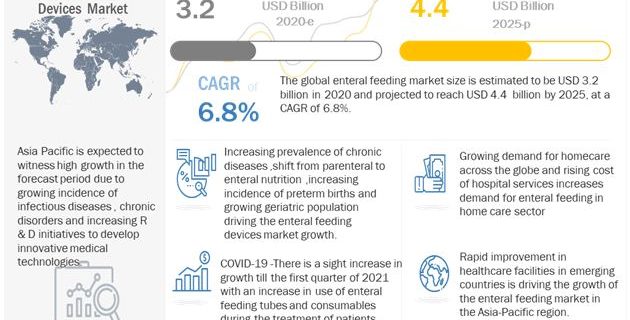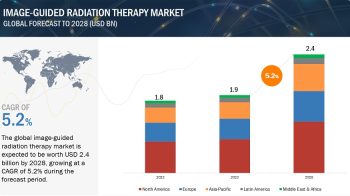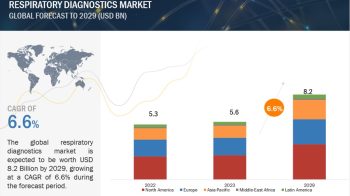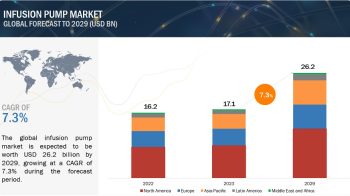
What This Report
Will Provide?
This study involved four major
activities in estimating the current size of the enteral feeding devices
market. Exhaustive secondary research was carried out to collect information on
the market, its peer markets, and its parent market.
The next step was to validate these findings, assumptions, and sizing with
industry experts across the value chain through primary research. Both top-down
and bottom-up approaches were employed to estimate the complete market size.
After that, market breakdown and data triangulation procedures were used to
estimate the size of segments and subsegments.
Expected Revenue Growth:
[460 Pages Report] The enteral feeding devices market is projected to reach USD 4.4 billion by 2025
from USD 3.2 billion in 2020, at a CAGR of 6.8%
Major Growth Boosters:
The enteral feeding devices
market has evolved significantly owing to various technological advancements,
such as programming and safety features in feeding pumps as well as
user-friendly and portable feeding pumps. Factors such as rising healthcare
costs; surge in the number of preterm births; growth in the aging population;
rising prevalence of chronic diseases such as diabetes, cancer,
gastrointestinal diseases, and neurological disorders; growing awareness of
enteral nutrition; and rapid improvements in healthcare facilities in emerging
countries are expected to further drive the market during the forecast period.
Download PDF Brochure:
https://www.marketsandmarkets.com/pdfdownloadNew.asp?id=183623035
Recent Development:
In 2019, Fresenius Kabi completed the
expansion of its plant in Aquiraz, Brazil, and increased the facility’s
capacity for parental nutrition production by about 30%. The company has
invested ~USD 22.4 million (EUR 20 million) for this expansion.
In 2018, Fresenius Kabi invested USD 11 million (EUR 9 million) for the
expansion of its production facility in the UK, by undertaking the construction
of a new distribution and operations center, scheduled to open in 2019. This
expansion has been undertaken to meet the increasing demand from the country’s
home care market.
In 2018, Fresenius Kabi invested over USD 25 million (EUR 20 million) to expand
its medical devices production site in Haina, Dominican Republic.
Key Questions Addressed in The Report:
1. Who are the top 10 players operating in the global enteral feeding
devices market?
2. What are the drivers, restraints, opportunities, and challenges in the
enteral feeding devices Industry?
3. What are the opportunities for stakeholders and provide details of the
competitive landscape for key players?
4. What will be growth of enteral feeding devices in North America, Europe,
Asia Pacific, Latin America, and the Middle East and Africa?
Enteral Feeding Tubes to Dominate the Market:
The enteral feeding tubes
segment accounted for the largest share of the enteral feeding devices market.
The rising adoption of enteral feeding has resulted in an increase in the
demand and uptake of enteral feeding tubes across the globe. These device
modifications include the use of bright orange or purple tubing (solid and
striped), “enteral-only” labels, and manufacturer-specific enteral-only or
non-IV compatible connectors. Moreover, the Global Enteral Device Supplier
Association (GEDSA), an international working group of enteral feeding tube
manufacturers, distributors, and suppliers, has introduced new enteral
connectors (ENFit) that conform to the new ISO standards. This universal
connector design has been introduced to improve patient safety and reduce the
incidence of medical device tubing misconnections.
Request Sample Report:
https://www.marketsandmarkets.com/requestsampleNew.asp?id=183623035
Key Players:
The
prominent players in this market are Fresenius Kabi AG (Germany), Avanos
Medical, Inc. (US), Cardinal Health, Inc. (US), B. Braun Melsungen AG
(Germany), Abbott Laboratories (US), Becton, Dickinson and Company (US), Boston
Scientific Corporation (US), Cook Medical, Inc. (US), CONMED Corporation
(CONMED) (US), Nestlé S.A. (Switzerland).


